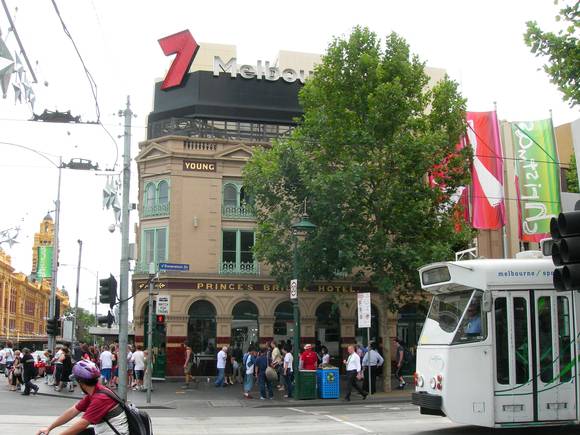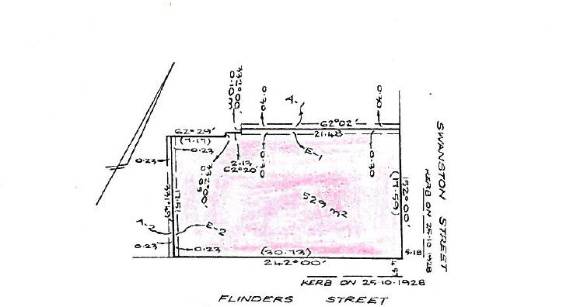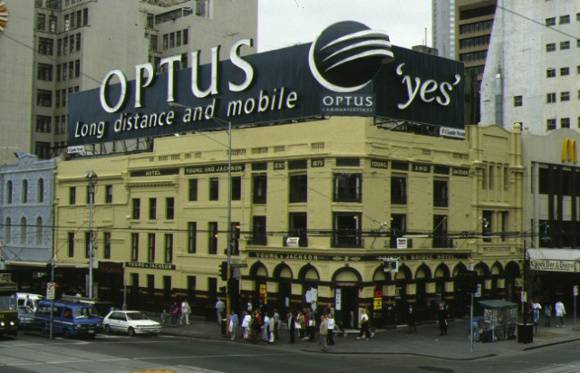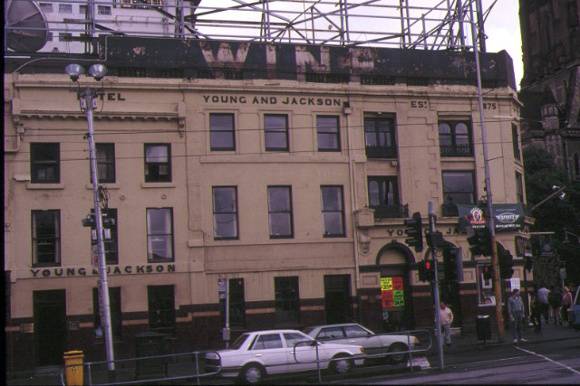| Back to search results » | Back to search page » |
|
YOUNG AND JACKSON'S PRINCES BRIDGE HOTEL
Other NameYoung & Jacksons Location1-7 SWANSTON STREET MELBOURNE, MELBOURNE CITY
File Number14/003125-01LevelRegistered |
|
Statement of Significance
What is significant? Young and Jackson's Princes Bridge Hotel is an amalgamation of five
separate buildings of two and three storeys. The original 1853
bluestone building was designed as a three-storey residence, with a
butcher's shop on the ground floor. It opened as a hotel in July 1861
with John T Toohey as licensee. It was later extended in both
directions, incorporating a shop to the north in Swanston Street and
two early bluestone stores to the west on Flinders Street. All the
buildings have been rendered and painted to match each other but the
original stone corner building can be readily identified. In 1875
Henry Figsby Young and Thomas Jackson took over the licence, extended
the hotel and gave it the name by which it is now popularly known. The
architect John Flannigan and the builder Henry Wright undertook the
renovations, including the removal of the original timber shopfronts
and the addition of the brick parapets and pediments. In 1908 Henry
Young purchased the painting Chloe and displayed it in the saloon bar.
Chloe is a painting of a nude female by the Frenchman Jules Lefebvre.
This painting had been the subject of public outcry when it had been
shipped to Melbourne for the 1880-81 International Exhibition at the
Royal Exhibition Buildings. Its display at the hotel ensured great
publicity for Young. Young sold his leasehold in 1914 to the brewer
Stephen Morell. During Morell's tenancy the hotel absorbed another of
the former stores extending west along Flinders Street. In 1921 the
freeholder united all the previous perimeter occupancies to form one
large hotel facade. The architect of this work was the hotel
specialist Richard B Whittaker. The red glaze tile dado and ornamental
frieze was added to combat the grime at ground level. The streetscape
of the hotel is dominated by large advertising signs fixed to the
exterior, a feature of the hotel since the 1920s. How is it significant? Young and Jackson?s Princes Bridge Hotel is of historical
significance to the State of Victoria. Why is it significant? Young and Jackson's Princes Bridge Hotel is historically significant
as one of Melbourne's oldest, most important and successful nineteenth
century hotels. Its popularity was achieved partly because of its
occupation of the key corner site facing Princes Bridge and Flinders
Street Railway Station. Since the 1920s commercial signs have also
played an important role in establishing Young and Jackson's landmark
quality. The hotel is historically significant for the public display
of the painting Chloe since 1908. Chloe not only helped to promote the
hotel but also came to symbolise popular resistance to conservative
Victorian values. Chloe is intimately connected to the significance of
Young and Jackson's Princes Bridge Hotel and has changed hands with
changes of ownership of the hotel. Young and Jackson's Princes Bridge
Hotel is additionally historically significant as one of the first
hotels to be chosen in 1888 by the Foster Brothers to sell their
revolutionary new lager beer, which later came to dominate the market
for bottled beer. Young and Jackson's Princes Bridge Hotel is
historically significant for its associations with Stephen J Morrell,
licensee from 1914. Morrell helped establish the Abbotsford Brewery
and became Mayor of Melbourne in 1926. Young and Jackson's Princes Bridge Hotel is socially significant as
one of the most famous pubs in Australia. It is one of the
international symbols of Melbourne and the hotel retains its status as
a pub destination for tourists and for ex-servicemen who were based in
Melbourne during the Second World War. The hotel is a prominent
Melbourne landmark on the Flinders Street and Swanston Street
intersection and retains a close relationship with Flinders Street
Railway Station located opposite.
Group
Recreation and Entertainment
Category
Hotel







